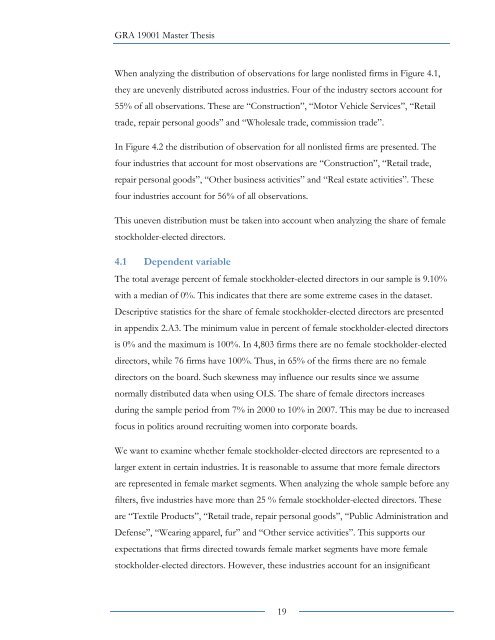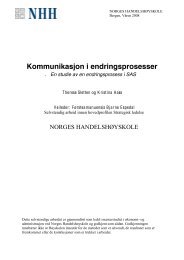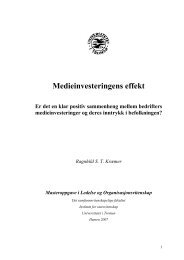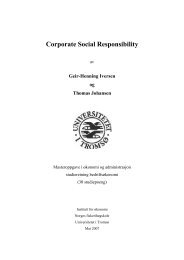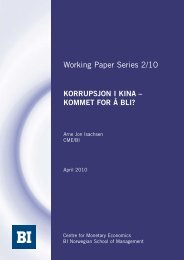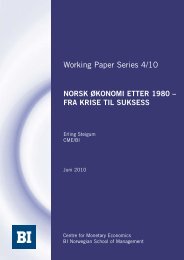Gender Diversity on the Board - BI Norwegian Business School
Gender Diversity on the Board - BI Norwegian Business School
Gender Diversity on the Board - BI Norwegian Business School
Create successful ePaper yourself
Turn your PDF publications into a flip-book with our unique Google optimized e-Paper software.
GRA 19001 Master Thesis<br />
When analyzing <strong>the</strong> distributi<strong>on</strong> of observati<strong>on</strong>s for large n<strong>on</strong>listed firms in Figure 4.1,<br />
<strong>the</strong>y are unevenly distributed across industries. Four of <strong>the</strong> industry sectors account for<br />
55% of all observati<strong>on</strong>s. These are “C<strong>on</strong>structi<strong>on</strong>”, “Motor Vehicle Services”, “Retail<br />
trade, repair pers<strong>on</strong>al goods” and “Wholesale trade, commissi<strong>on</strong> trade”.<br />
In Figure 4.2 <strong>the</strong> distributi<strong>on</strong> of observati<strong>on</strong> for all n<strong>on</strong>listed firms are presented. The<br />
four industries that account for most observati<strong>on</strong>s are “C<strong>on</strong>structi<strong>on</strong>”, “Retail trade,<br />
repair pers<strong>on</strong>al goods”, “O<strong>the</strong>r business activities” and “Real estate activities”. These<br />
four industries account for 56% of all observati<strong>on</strong>s.<br />
This uneven distributi<strong>on</strong> must be taken into account when analyzing <strong>the</strong> share of female<br />
stockholder-elected directors.<br />
4.1 Dependent variable<br />
The total average percent of female stockholder-elected directors in our sample is 9.10%<br />
with a median of 0%. This indicates that <strong>the</strong>re are some extreme cases in <strong>the</strong> dataset.<br />
Descriptive statistics for <strong>the</strong> share of female stockholder-elected directors are presented<br />
in appendix 2.A3. The minimum value in percent of female stockholder-elected directors<br />
is 0% and <strong>the</strong> maximum is 100%. In 4,803 firms <strong>the</strong>re are no female stockholder-elected<br />
directors, while 76 firms have 100%. Thus, in 65% of <strong>the</strong> firms <strong>the</strong>re are no female<br />
directors <strong>on</strong> <strong>the</strong> board. Such skewness may influence our results since we assume<br />
normally distributed data when using OLS. The share of female directors increases<br />
during <strong>the</strong> sample period from 7% in 2000 to 10% in 2007. This may be due to increased<br />
focus in politics around recruiting women into corporate boards.<br />
We want to examine whe<strong>the</strong>r female stockholder-elected directors are represented to a<br />
larger extent in certain industries. It is reas<strong>on</strong>able to assume that more female directors<br />
are represented in female market segments. When analyzing <strong>the</strong> whole sample before any<br />
filters, five industries have more than 25 % female stockholder-elected directors. These<br />
are “Textile Products”, “Retail trade, repair pers<strong>on</strong>al goods”, “Public Administrati<strong>on</strong> and<br />
Defense”, “Wearing apparel, fur” and “O<strong>the</strong>r service activities”. This supports our<br />
expectati<strong>on</strong>s that firms directed towards female market segments have more female<br />
stockholder-elected directors. However, <strong>the</strong>se industries account for an insignificant<br />
19


